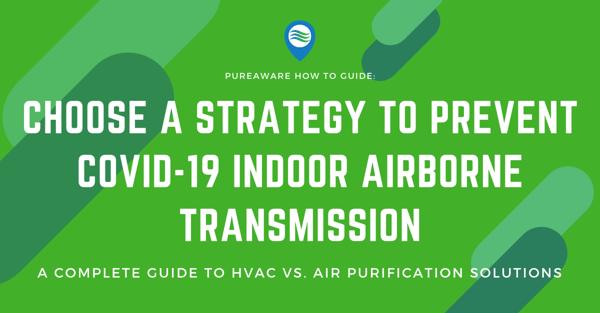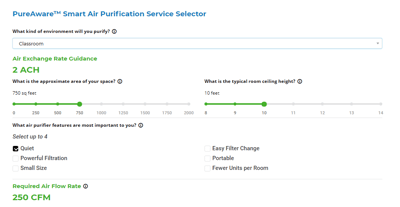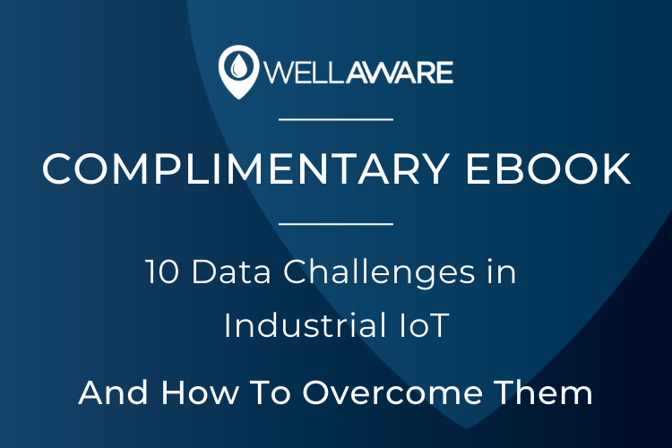
News, Insights, and more on Industrial IoT

Right now, everyone is looking at buying air purifiers. The knowledge that COVID-19 can spread through airborne aerosolized droplets has motivated many organizational leaders to look into the technology. However, there is no one-size-fits-all solution.
Two questions we see come up over and over again are:
These are both very important questions, and it turns out that there is a lot of science behind the right answers. Here, we’ll address these questions and share CDC guidelines to help you make an informed decision about how to best protect your occupants, whether you run a for-profit business, school, health care facility, or other type of organization.

Not sure how to improve air change rates in your spaces? Download this eBook for the details on all of the best air cleaning strategies, including prices, effectiveness, and safety warnings.
When researching air purifiers, you’ll likely come across an unfamiliar abbreviation - “ACH” - which stands for “air changes per hour.” Put simply, it’s the number of times all of the air in a space is replaced with “new” air.
As you can imagine, ACH plays a vital role in the effectiveness of air purification strategies. In a world where facilities managers need to keep indoor spaces free from airborne pathogens, such as COVID-19, understanding how many times air should “turnover” is crucial.
Implementing proper ACH is critical for maintaining clean, contaminant-free air. When tackling aerosolized COVID-19, air exchange rate is a key metric for facilities managers to understand. Too few air changes per hour gives viruses a greater chance to spread between people. Too many, on the other hand, increases utility spend for purifiers, energy, and filters unnecessarily, creating additional economic risk in an already-tough financial environment.
The CDC has put forth recommendations for ACH in clinical environments to help administrators maintain effective infection control practices. ACH values range from 2 to 12 or more, depending on the function of the environment. For example, operating and procedure rooms have a minimum-recommended ACH of 15 due to the significant risk of infectious aerosol creation.
When evaluating an air purifier, it’s important to understand that your ability to remove contaminants from the air is directly proportional to two things:
The following table, provided by the CDC, demonstrates how ACH and air purifier efficiency affect the time it takes to remove a known contaminant from a space. The more air changes, and the more effective the purifier is at removing that contaminant, the better the purifier will work at preventing infection.
| ACH | Time (mins.) required for removal 99% efficiency |
Time (mins.) required for removal 99.9% efficiency |
|---|---|---|
| 2 | 138 | 207 |
| 4 | 69 |
104 |
| 6 | 46 | 69 |
| 8 | 35 | 52 |
| 10 | 28 | 41 |
| 12 | 23 | 35 |
| 15 | 18 | 28 |
| 20 | 14 | 21 |
| 50 | 6 | 8 |
Table adapted from the CDC's Environmental Infection Control Guidelines, Appendix B.
Ultimately, you need to figure out how many air changes per hour will minimize COVID-19 viral load enough to prevent spread within your building, assuming occupants are also practicing social distancing.
Note: no air purifiers can completely eliminate the risk of infection, but they can significantly reduce the presence of aerosolized particles if sized properly to the space.
The formula for calculating ACH is relatively simple:
ACH = Air Purifier Fan Rating (CFM) * 60 / [Room Size (sq ft) * Ceiling Height (ft)]
So, a 750 sq. ft room with 10 ft. ceilings and an air purifier rated for 250 CFM would enable 2 air changes per hour (see below):
ACH = 250 CFM * 60 / (750 sq ft * 10 ft)
ACH = 250 * 60 / 7,500
ACH = 15,000 / 7,500
ACH = 2
Understanding the ACH of the air purifier you select in the room in which you place it is an important part of the selection process. It is, however, only part of the equation. The actual number of ACH you need depends on a few variables, specifically environmental conditions and the rate of infectious aerosol creation in your room.
Put simply: if someone in your building is sick, whether symptomatic or asymptomatic, what should your ACH be?
The exact number of air changes per hour you need depends on several factors, some of which are unknown. But, we can look at research and data as a starting point. In reality, there are three essential factors to consider:
Unfortunately, we don’t have clear answers for the first two in the list as it relates to COVID-19. More research is needed before we understand the rate at which normal human activity creates aerosolized particles containing SARS-CoV-2, and how many of those particles somebody needs to breathe in a certain period of time to become infected.
We can however, use existing guidelines from the CDC to get an idea. As we mentioned above, the CDC has published ACH guidelines for various clinical spaces depending on risk level.
In general, the CDC recommends between 6-12 air changes per hour in rooms where infected persons are likely to reside. These include hospital patient rooms, treatment rooms, ER waiting rooms, and airborne infection isolation rooms. At a minimum, the CDC recommends 2 ACH for any clinical space.
| Space | Recommended ACH |
| Residence Room | 2 |
| Dining Rooms | 4 |
| Patient Rooms | 6 |
| ER Waiting Rooms | 12 |
| Operating Rooms | 15 |
CDC recommended air change rates for certain clinical spaces
We can use these recommendations to get guidance on non-clinical spaces. The important question to answer: How likely is it that somebody with COVID-19 will walk into a particular space, and how much time will they spend in that space?
In an office hallway or lobby for example, the likelihood is somewhat high that somebody sick will be in that space, however they probably won’t spend much time there. In a conference room, perhaps the likelihood of somebody being in the space goes down slightly, but the time spent in the confined space increases significantly. In a school nurse’s office, it is extremely likely that a child with COVID-19 will enter that space at some point, and they will likely spend a fair amount of time being diagnosed and lightly treated before being sent home.
The point is, the required ACH depends on the level of risk in a space, and the risk tolerance of the organization. While we can’t make any claims as to whether certain ACH levels will eliminate or mitigate airborne transmission of aerosolized viruses, we do think the following guidance is appropriate based on our research:
*Note - We are not medical professionals, infectious disease experts, nor fluid dynamicists. Our recommendations above are based solely on our research and our best understanding of air change rates, and are not meant as professional or medical advice. No amount of air changes can eliminate airborne transmission of viruses.
Remember, the time it takes to effectively remove airborne pathogens from a space depends both on ACH and air purification efficiency. As such, select the highest possible efficiency rating in an air purifier. The very best air purifiers have efficiencies of greater than 99.9% for airborne contaminants like viruses, bacteria, and mold.

Also keep in mind that existing HVAC infrastructure contributes to air change rates and filtering efficiency. Make sure you understand the specification of your HVAC system and how it delivers fresh or filtered air to each of your spaces.
At the end of the day, the answer depends on your risk tolerance. The higher your air purifier ACH and efficiency, the faster you can remove contaminants from a room. We’ve built a handy calculator to make things easier for you in this process. Although we don’t know exactly how many ACHs are suitable for COVID-19, you can take steps now to lower exposure risk for your occupants.

Having a data challenge? You're not alone.
Sign up for our blog and receive a free eBook on the 10 data challenges in Industrial IoT and how to overcome them.
Have a Question?